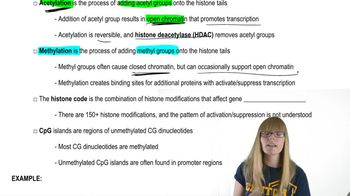Part of the Ras protein is associated with the plasma membrane, and part extends into the cytoplasm. How does the Ras protein transmit a signal from outside the cell into the cytoplasm? What happens in cases where the ras gene is mutated?
Table of contents
- 1. Introduction to Genetics51m
- 2. Mendel's Laws of Inheritance3h 37m
- 3. Extensions to Mendelian Inheritance2h 41m
- 4. Genetic Mapping and Linkage2h 28m
- 5. Genetics of Bacteria and Viruses1h 21m
- 6. Chromosomal Variation1h 48m
- 7. DNA and Chromosome Structure56m
- 8. DNA Replication1h 10m
- 9. Mitosis and Meiosis1h 34m
- 10. Transcription1h 0m
- 11. Translation58m
- 12. Gene Regulation in Prokaryotes1h 19m
- 13. Gene Regulation in Eukaryotes44m
- 14. Genetic Control of Development44m
- 15. Genomes and Genomics1h 50m
- 16. Transposable Elements47m
- 17. Mutation, Repair, and Recombination1h 6m
- 18. Molecular Genetic Tools19m
- 19. Cancer Genetics29m
- 20. Quantitative Genetics1h 26m
- 21. Population Genetics50m
- 22. Evolutionary Genetics29m
19. Cancer Genetics
Cancer Mutations
Problem 19
Textbook Question
Cancer can be defined as an abnormal proliferation of cells that defy the normal regulatory controls observed by normal cells. Recently, histone deacetylation therapies have been attempted in the treatment of certain cancers [reviewed by Delcuve et al. (2009)]. Specifically, the FDA has approved histone deacetylation (HDAC) inhibitors for the treatment of cutaneous T-cell lymphoma. Explain why histone acetylation might be associated with cancer and what the rationale is for the use of HDAC inhibitors in the treatment of certain forms of cancer.
 Verified step by step guidance
Verified step by step guidance1
Understand the role of histone acetylation in gene expression: Histone acetylation involves the addition of acetyl groups to histone proteins, which reduces the positive charge on histones and weakens their interaction with negatively charged DNA. This process makes the chromatin structure more open, allowing transcription factors and RNA polymerase to access DNA and promote gene expression.
Recognize the connection between histone acetylation and cancer: In cancer, abnormal histone acetylation patterns can lead to the overexpression of oncogenes (genes that promote cell proliferation) or the silencing of tumor suppressor genes (genes that inhibit cell proliferation). This imbalance can contribute to uncontrolled cell growth and cancer development.
Understand the mechanism of histone deacetylation: Histone deacetylation is the removal of acetyl groups from histones, leading to a more compact chromatin structure and reduced gene expression. Histone deacetylases (HDACs) are enzymes responsible for this process, and their dysregulation can also contribute to cancer by silencing tumor suppressor genes.
Explore the rationale for HDAC inhibitors in cancer therapy: HDAC inhibitors block the activity of histone deacetylases, preventing the removal of acetyl groups from histones. This can restore the expression of tumor suppressor genes and reduce the expression of oncogenes, thereby inhibiting cancer cell proliferation and promoting apoptosis (programmed cell death).
Consider the specific application to cutaneous T-cell lymphoma: The FDA-approved HDAC inhibitors for cutaneous T-cell lymphoma work by targeting the epigenetic dysregulation in these cancer cells. By modulating histone acetylation, these therapies aim to restore normal gene expression patterns and control the abnormal proliferation of T-cells.
 Verified video answer for a similar problem:
Verified video answer for a similar problem:This video solution was recommended by our tutors as helpful for the problem above
Video duration:
2mPlay a video:
Was this helpful?
Key Concepts
Here are the essential concepts you must grasp in order to answer the question correctly.
Histone Acetylation
Histone acetylation is a post-translational modification where acetyl groups are added to histone proteins, leading to a more relaxed chromatin structure. This modification enhances gene expression by allowing transcription factors easier access to DNA. In cancer, abnormal patterns of histone acetylation can result in the overexpression of oncogenes or the silencing of tumor suppressor genes, contributing to uncontrolled cell proliferation.
Recommended video:
Guided course

Histone Protein Modifications
Histone Deacetylases (HDACs)
Histone deacetylases (HDACs) are enzymes that remove acetyl groups from histones, leading to a more compact chromatin structure and reduced gene expression. In cancer, HDACs can be overactive, resulting in the repression of genes that normally inhibit cell growth and promote apoptosis. This dysregulation of HDAC activity is a key factor in the development and progression of various cancers.
Recommended video:
Guided course

Histone Protein Modifications
HDAC Inhibitors
HDAC inhibitors are a class of drugs that block the activity of histone deacetylases, thereby increasing histone acetylation and promoting a more open chromatin structure. This can reactivate silenced tumor suppressor genes and restore normal cell cycle regulation. The FDA-approved HDAC inhibitors for certain cancers, such as cutaneous T-cell lymphoma, aim to reverse the aberrant gene expression patterns associated with malignancies, offering a targeted therapeutic approach.
Related Videos
Related Practice
Textbook Question
433
views


